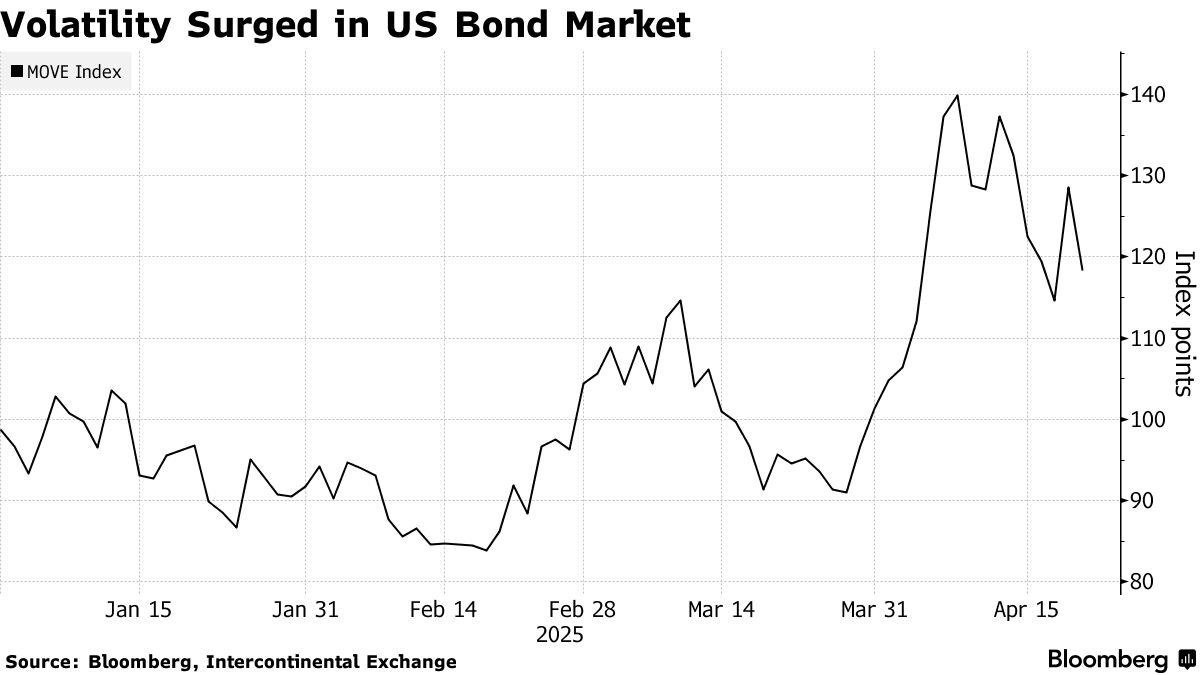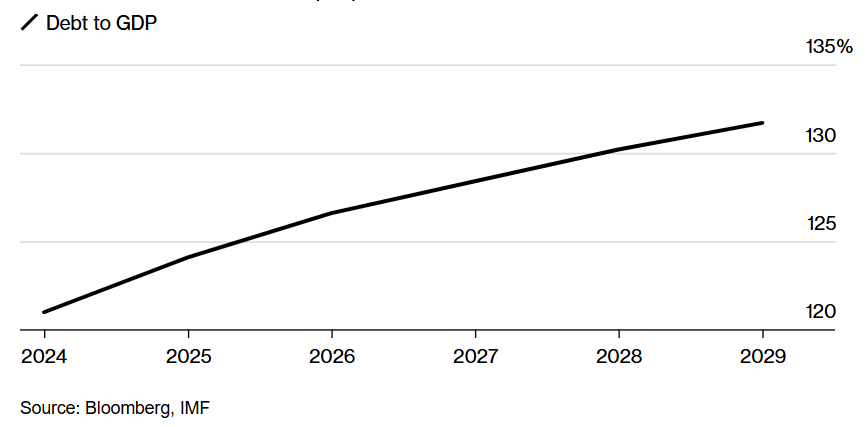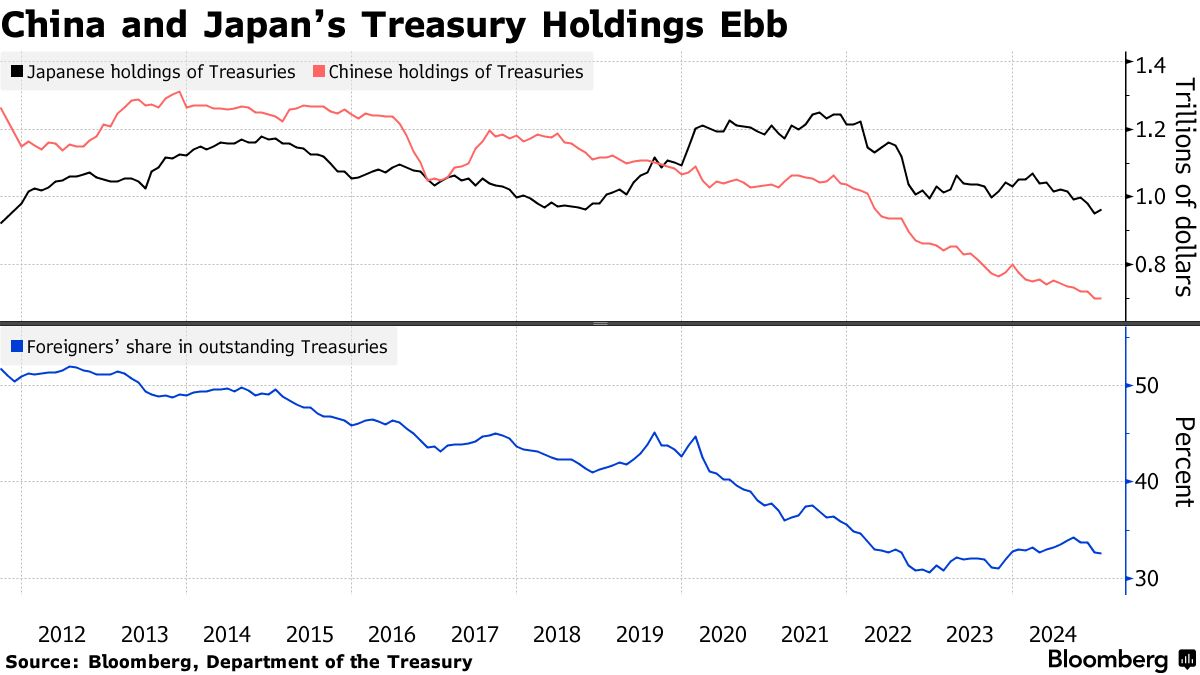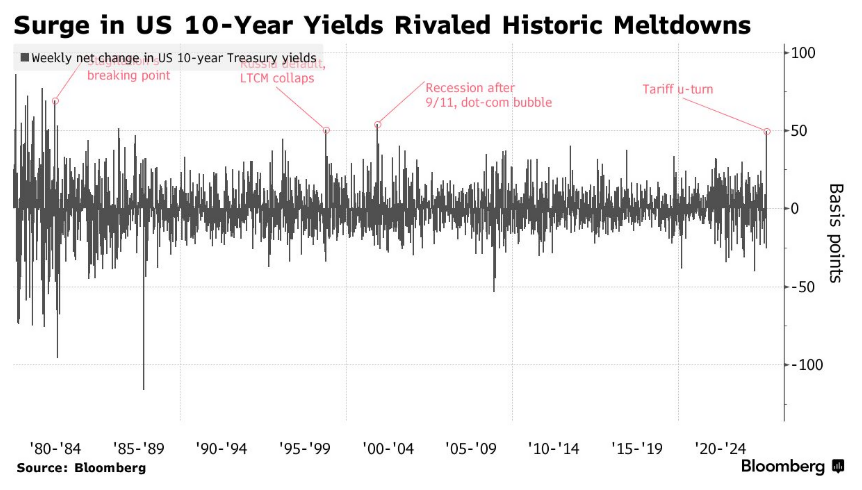Author: Alice Atkins & Liz Capo McCormick, Bloomberg
Compiled by: Felix, PANews
Investors typically flock to U.S. Treasuries to avoid turmoil in financial markets. During the global financial crisis, the 9/11 attacks, and even when the U.S. credit rating was downgraded, U.S. Treasuries rebounded.
However, in early April, amidst the chaos triggered by President Trump's implementation of "reciprocal" tariffs, something unusual occurred. As risk assets like stocks and cryptocurrencies plummeted, U.S. Treasury prices not only failed to rise but also fell. U.S. Treasury yields recorded their largest weekly increase in over twenty years.
For a long time, the $29 trillion U.S. Treasury market has been viewed as a safe haven during market turmoil, a unique advantage of the world's largest economy. For decades, it has helped the U.S. control borrowing costs. But recently, the trading performance of U.S. Treasuries has resembled that of a risk asset. Former Treasury Secretary Lawrence Summers even stated that U.S. Treasuries are performing like the debt of emerging market countries.
This has profound implications for the global financial system. As the world's "risk-free" asset, U.S. Treasuries are used as a benchmark for pricing various assets, from stocks to sovereign bonds and mortgage rates, while also serving as collateral for trillions of dollars in loans every day.
Here are some perspectives from investors and market forecasters to explain the unusual fluctuations in U.S. Treasuries in April, as well as some potential alternative "safe havens."
Tariff-Driven Inflation
Even though Trump has suspended most "reciprocal" tariffs for 90 days, the tariffs imposed on China remain significantly higher than previously expected. Tariffs are still levied on cars, steel, aluminum, and various goods from Canada and Mexico, and Trump has threatened to impose more import tariffs in the future.
There are concerns that companies will pass these tariff costs onto consumers in the form of higher prices. An inflation shock would dampen demand for Treasuries, as it would erode the future value of the fixed income payments they provide.
If prices soar while economic output declines or stagnates (the so-called stagflation), monetary policy will enter a new period of uncertainty, forcing the Federal Reserve to choose between supporting economic growth and curbing inflation.

Chasing Cash
Some investors may have sold U.S. Treasuries and other U.S. assets in favor of the ultimate safe haven: cash. As the Federal Reserve delayed interest rate cuts, the asset size in U.S. money market funds has continued to soar, reaching a record high in the week ending April 2. Money market funds are typically viewed as cash equivalents, with the added benefit of generating returns over time.
Policy Uncertainty
Investors demand higher returns when investing in countries with political turmoil and economic instability. This is one reason why Argentine government bonds had yields as high as 13% in mid-April.
Trump's unpredictable political strategies and aggressive tariff policies make it difficult to predict how friendly the U.S. investment environment will be a year from now.
Another factor driving capital inflows into the U.S. is the belief that the strength of the U.S. judicial system and other national institutions can constrain the government and ensure a degree of policy continuity. Trump's willingness to challenge lawyers who impede his actions and to force the Federal Reserve and other independent agencies to bend to his will may undermine some people's confidence in the checks and balances that have helped make the U.S. the largest destination for foreign investment.
Fiscal Pressure
In the mid-1970s, the dollar replaced gold as the world's reserve asset, prompting central banks to purchase U.S. Treasuries to store dollar reserves. Because the federal government has never defaulted on its debt obligations, U.S. Treasuries have been viewed as a solid investment.
U.S. Treasuries currently account for 121% of GDP. From the outset of his presidency, Trump has bet that stimulating economic growth through tax cuts will reduce the budget deficit, and he has recently hinted that tariff revenues will also help alleviate the deficit.
However, there are concerns that his policies will only exacerbate national debt. In addition to his proposed additional tax cuts, Trump is attempting to make the tax cuts implemented during his first term permanent. If tariffs lead to an economic recession, the government may face pressure to increase spending.
In light of this, Fidelity International fixed income investment manager Mike Riddell stated that the spiraling rise in U.S. Treasury yields may signal "capital flight," as foreign investors become increasingly unwilling to fund the U.S. deficit. "The global 'bond vigilantes' are clearly still active."
U.S. Debt Levels Expected to Rise

The International Monetary Fund predicts that by 2029, the U.S. debt-to-GDP ratio will reach 131.7%._
Foreign Sell-Offs
While it is difficult to prove in real-time, when U.S. Treasury prices fall, it is often speculated that foreign entities are selling off. This time, some believe it is a response to Trump's tariff policies. China and Japan are the largest holders of U.S. Treasuries. Official data shows that both countries have been reducing their holdings for some time.
Given that China's trading activities are highly confidential, it is challenging to speculate on the role of the Chinese government in this. However, strategists often point out that the U.S. Treasuries held by China may serve as a potential bargaining chip against the U.S.—even a large sell-off could depress the value of China's foreign exchange reserves.

Hedge Fund Trading
Basis trading may be one reason for the surge in U.S. Treasury yields in early April. This is a popular hedge fund strategy that profits from the price difference between cash Treasuries and futures.
This price difference is usually small, so investors often use significant leverage to fund their trades. When market turmoil strikes and investors rush to quickly close positions to repay loans, it can trigger problems. The risk is that this could lead to a chain reaction, causing yields to spiral upward and, worse, leading to a freeze in the Treasury market, similar to what happened during the basis trading unwind in 2020.
Others point out that the previously popular bet on "U.S. Treasuries outperforming interest rate swaps" suddenly collapsed. In fact, interest rate swaps performed well because banks liquidated bonds to meet clients' liquidity needs and then increased swap contracts to maintain exposure in case the bond market might rise.

If not U.S. Treasuries, then what?
Fund managers in Europe and Japan are finding that there are now reliable alternatives to purchasing U.S. Treasuries, which may attract them to shift their allocations to markets where the policy outlook seems more stable. Amid broader turmoil, German bonds are one of the main beneficiaries.
Gold, a traditional safe-haven asset, surged to historic highs in April, outperforming nearly all other major asset classes. Central banks have been hoarding this precious metal for some time in hopes of diversifying assets and reducing reliance on dollar assets. However, unlike bonds, investing in gold does not provide fixed income. Returns from investing in gold only materialize when sold at a higher price.
Ultimately, no investment can offer the liquidity and depth of the U.S. Treasury market; withdrawing from the U.S. Treasury market would take years, not weeks. However, some market observers believe that the market movements in April may signal a shift in the global landscape and a reassessment of assets critical to the dominance of the U.S. economy.
Related Articles: From Price Declines to Fiscal Dilemmas: The Chain Reaction of U.S. Treasury Sell-Offs
免责声明:本文章仅代表作者个人观点,不代表本平台的立场和观点。本文章仅供信息分享,不构成对任何人的任何投资建议。用户与作者之间的任何争议,与本平台无关。如网页中刊载的文章或图片涉及侵权,请提供相关的权利证明和身份证明发送邮件到support@aicoin.com,本平台相关工作人员将会进行核查。




